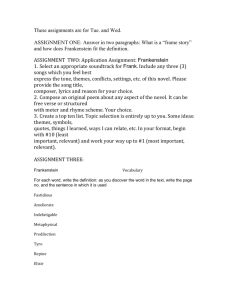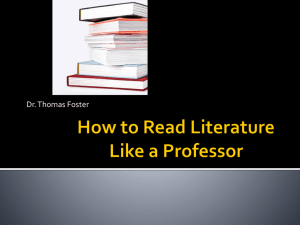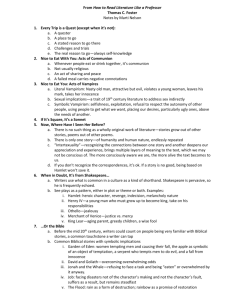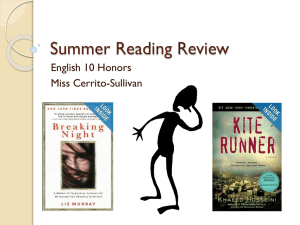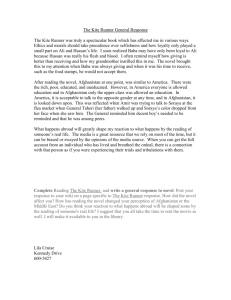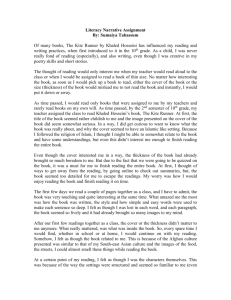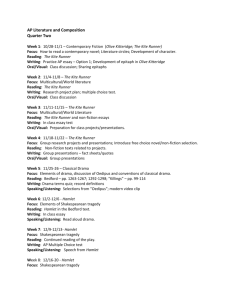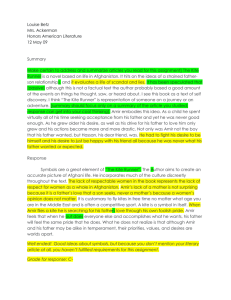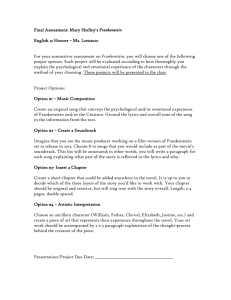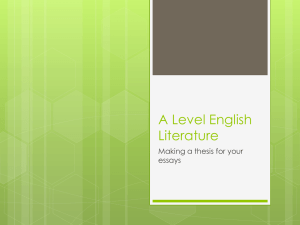The Kite Runner, Beloved - Campbell County Schools
advertisement
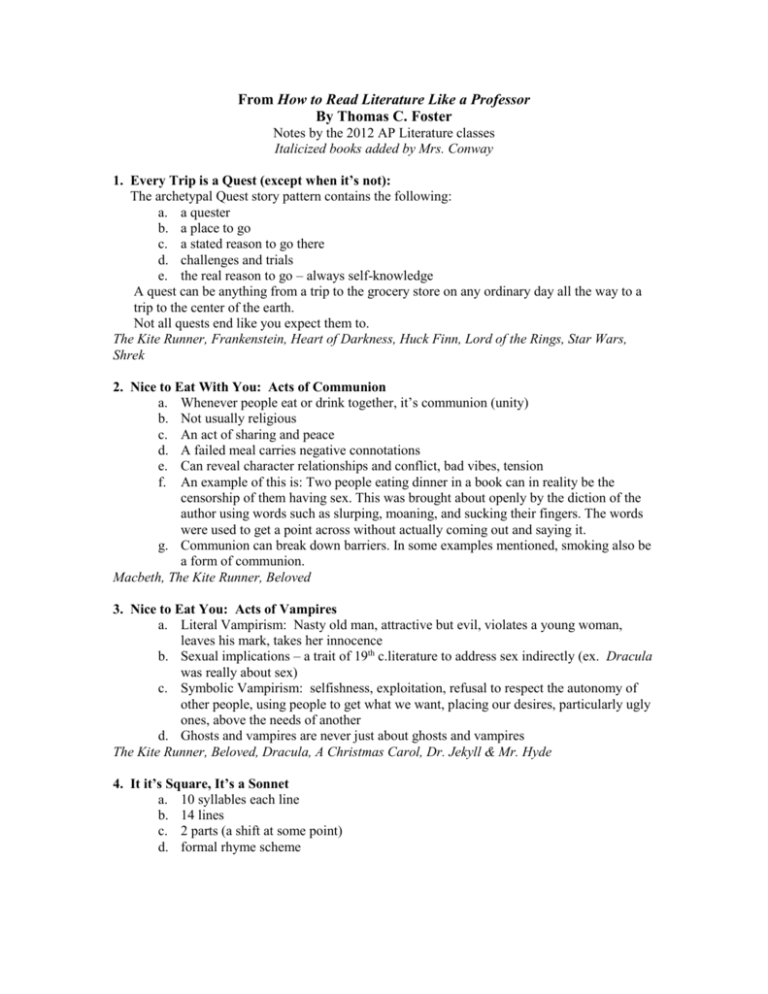
From How to Read Literature Like a Professor By Thomas C. Foster Notes by the 2012 AP Literature classes Italicized books added by Mrs. Conway 1. Every Trip is a Quest (except when it’s not): The archetypal Quest story pattern contains the following: a. a quester b. a place to go c. a stated reason to go there d. challenges and trials e. the real reason to go – always self-knowledge A quest can be anything from a trip to the grocery store on any ordinary day all the way to a trip to the center of the earth. Not all quests end like you expect them to. The Kite Runner, Frankenstein, Heart of Darkness, Huck Finn, Lord of the Rings, Star Wars, Shrek 2. Nice to Eat With You: Acts of Communion a. Whenever people eat or drink together, it’s communion (unity) b. Not usually religious c. An act of sharing and peace d. A failed meal carries negative connotations e. Can reveal character relationships and conflict, bad vibes, tension f. An example of this is: Two people eating dinner in a book can in reality be the censorship of them having sex. This was brought about openly by the diction of the author using words such as slurping, moaning, and sucking their fingers. The words were used to get a point across without actually coming out and saying it. g. Communion can break down barriers. In some examples mentioned, smoking also be a form of communion. Macbeth, The Kite Runner, Beloved 3. Nice to Eat You: Acts of Vampires a. Literal Vampirism: Nasty old man, attractive but evil, violates a young woman, leaves his mark, takes her innocence b. Sexual implications – a trait of 19th c.literature to address sex indirectly (ex. Dracula was really about sex) c. Symbolic Vampirism: selfishness, exploitation, refusal to respect the autonomy of other people, using people to get what we want, placing our desires, particularly ugly ones, above the needs of another d. Ghosts and vampires are never just about ghosts and vampires The Kite Runner, Beloved, Dracula, A Christmas Carol, Dr. Jekyll & Mr. Hyde 4. It it’s Square, It’s a Sonnet a. 10 syllables each line b. 14 lines c. 2 parts (a shift at some point) d. formal rhyme scheme 5. Now, Where Have I Seen Her Before? a. There is no such thing as a wholly original work of literature – stories grow out of other stories, poems out of other poems b. There is only one story – of humanity & human nature, endlessly repeated c. “Intertextuality” – recognizing the connections between one story and another deepens our appreciation and experience, brings multiple layers of meaning to the text, which we may not be conscious of. The more consciously aware we are, the more alive the text becomes to us. d. If you don’t recognize the correspondences, it’s ok. If a story is no good, being based on Hamlet won’t save it. e. Look for patterns, recurrences, archetypes, etc. Alice in Wonderland, Beowulf 6. When in Doubt, It’s from Shakespeare… a. Writers use what is common in a culture as a kind of shorthand. Shakespeare is allencompassing, so he is frequently echoed. b. Sees plays as a pattern, either in plot or theme or both. Examples: Hamlet – heroic character, revenge, indecision, melancholy nature Henry IV – a young man who must grow up to become king takes on his responsibilities Othello – jealousy Merchant of Venice – justice vs. mercy King Lear – aging parent, greedy children, a wise fool Macbeth – hunger for power 7. …Or the Bible a. Before the mid-20th c., writers could count on people being very familiar with Biblical stories, a common touchstone a writer can tap b. Biblical passages are often used in titles or as titles themselves c. Common Biblical stories with symbolic implications Garden of Eden – women tempting men and causing their fall, the apple as a symbol of an object of temptation, a serpent who tempts men to do evil, and a fall from innocence David and Goliath – overcoming overwhelming odds Jonah & the Whale – refusing to face a task and being “eaten” or overwhelmed by it anyway Job – facing disasters not of the character’s making and not the character’s fault, suffers as a result, but remains steadfast The Flood – rain as a form of destruction; rainbow as a promise of restoration Christ figures (a later chapter): in 20th c., often used ironically The Apocalypse – Four horsemen of the Apocalypse usher in the end of the world Biblical names often draw a connection between literary character and Biblical character Frankenstein, Beloved, Canterbury Tales 8. Hanseldee and Greteldum – using fairy tales and kid lit a. Hansel & Gretel – lost children trying to find their way home, candy house b. Peter Pan – refusing to grow up, lost boys, a girl-nurturer c. Little Red Riding Hood – See Vampires d. Alice in Wonderland, The Wizard of Oz – entering a world that doesn’t work rationally or operates under different rules, the Red Queen, the White Rabbit, the Cheshire Cat, the Wicked Witch of the West, the Wizard, who is a fraud e. Cinderella – orphaned girl abused by adopted family saved through supernatural intervention and by marrying a prince f. Snow White – evil woman who brings death to an innocent – again, saved by heroic/princely character g. Sleeping Beauty – a girl becoming a woman symbolically, the needle, blood=womanhood, the long sleep an avoidance of growing up and becoming a married woman, saved by (guess who) a prince who fights evil on her behalf h. Evil stepmothers, queens, Rumpelstiltskin i. Prince Charming – heroes who rescue women (20th c. frequently switched – the women saved the men – or used highly ironically) 9. It’s Greek to Me a. Myth is a body of story that matters – the patterns present in mythology run deeply in the human psyche b. Why writers echo myth – because there’s only one story (see ch. 4) c. Odyssey & The Iliad Men in an epic struggle over a woman Achilles – a small weakness in a strong man; the need to maintain one’s dignity Penelope (Odysseus’s wife) – the determination to remain faithful and to have faith Hector – the need to protect one’s family d. The Underworld – an ultimate challenge, facing the darkest parts of human nature or dealing with death e. Transformations, family triangles, being blinded, dysfunctional families, refusing to hear the truth, wronged woman gone violent in her grief and madness, mother’s love O Brother, Where Art Thou 10. It’s More than just Rain or Snow a. Rain Fertility and life Noah and the flood Drowning – one of our deepest fears Forces people together b. Why? Plot device Atmospherics Misery factor – challenge characters Democratic element – the rain falls on the just and the unjust alike c. Symbolically Rain is clean – a form of purification, baptism, removing sin or a stain Rain is restorative – can bring a dying earth back to life Destructive as well – causes pneumonia, colds, etc.; hurricanes, etc. Ironic use – April is the cruelest month (T.S. Eliot’s The Wasteland) Rainbow – God’s promise never to destroy the world again; hope; a promise of peace between heaven and earth Fog – almost always signals some sort of confusion: mental, ethical, physical “fog”; people can’t see clearly d. Snow Negatively – cold, stark, inhospitable, inhuman, nothingness, death, suffocation Positively – clean, pure, playful, inviting Frankenstein, The Kite Runner, Their Eyes Were Watching God, Beloved, A Farewell to Arms 11. …More Than It’s Gonna Hurt You: Concerning Violence a. Violence can be symbolic, thematic, Biblical, Shakespearean, Romantic, allegorical, transcendent b. Two categories of violence in literature Character caused – shootings, stabbings, drownings, poisonings, bomblings, hit and run, etc. Narrative violence that affects many; death and suffering for which the characters are not responsible; accidents are not really accidents c. When violence appears in literature, you can bet it has a deeper meaning than just the act itself. In real life this is also true, because there are normally motives behind brutal acts. d. Questions to ask: What does this type of misfortune represent thematically? What famous or mythic death does this one resemble? Why this sort of violence and not some other? The Kite Runner, Frankenstein, Macbeth, Beloved 12. Is That a Symbol? a. Yes. But figuring out what is tricky. Can only discuss possible meanings and interpretations. b. There is no one definite meaning unless it’s an allegory where characters, events, places have a one-on-one correspondence symbolically to other things (Animal Farm) c. Actions and characters, as well as objects and images, can be symbolic (“The Road Not Taken” by Robert Frost) d. How to figure it out? Symbols are built on associations readers have, but also on emotional reactions. Pay attention to how you feel about a text as you follow symbols throughout. Use your pre-existing knowledge. Ask questions: What does it mean? What does it stand for? What possibilities are suggested by the movement of the narration? e. Individual history is brought into the reading through educational attainment, race, gender, class, social involvement, faith, and philosophical inclination. Macbeth, Heart of Darkness 13. It’s All Political a. Literature tends to be written by people interested in the problems of the world, so most works have a political element in them b. When writing a literary piece, authors pick certain characters because they represent society in some way or because there’s something of the character within us and within society. c. Some tales from Edgar Allen Poe criticize the European class system, which privileges the unworthy and the unhealthy, and the end results are madness and death. d. Issues: Individualism and self-determination against the needs of society for conformity and stability Power structures Relations among classes Issues of justice and rights Interactions between the sexes and among various racial and ethnic constituencies The Kite Runner, Macbeth, Heart of Darkess, Beloved, A Christmas Carol, The Fall of the House of Usher 14. Yes, She’s a Christ Figure, Too a. Characteristics of a Christ Figure: Crucified, wounds in hands, feet, side, and head, often portrayed with arms outstretched In agony Self-sacrificing Good with children Good with loaves, fishes, water, wine 33 years of age when last seen employed as a carpenter known to use humble modes of transportation, feet or donkeys preferred believed to have walked on water known to have spent time alone in the wilderness believed to have had a confrontation with the devil, possibly tempted last seen in the company of thieves creator of many aphorisms and parables buried, but arose on the third day had disciples, twelve at first, although not all equally devoted very forgiving came to redeem an unworthy world b. As a reader, put aside belief system. c. Why use Christ figures? Deepens our sense of a character’s sacrifice, thematically has to do with redemption, hope, or miracles d. If used ironically, makes the character look smaller rather than greater The Kite Runner, Frankenstein, Old Man and the Sea 15. Flights of Fancy a. Flying was one of the temptations of Christ b. Wings are a symbol of freedom (ex. Angels have wings; they are free of all worldly problems c. Symbolically: freedom, escape, the flight of the imagination, spirituality, return home, largeness of spirit, love d. Interrupted flight generally a bad thing e. Usually not literal flying, but might use images of flying, birds, etc. f. Flying is a wondrous, magical, interesting thing to humans. g. Irony trumps everything 16. It’s All About Sex… a. Female symbols: chalice, Holy Grail, bowls, rolling landscapes, empty vessels waiting to be filled, tunnels, images of fertility b. Male symbols: blades, tall building, keys c. Stairs, waves, billowing curtains can symbolize sexual acts d. Why? Before mid-20th c., coded sex avoided censorship Can function on multiple levels Can be more intense than literal descriptions Frankenstein, The Kite Runner 17. …Except Sex a. When authors write directly about sex, they’re writing about something else, such as sacrifice, submission, rebellion, supplication, domination, enlightenment, etc. b. should reflect and create character and theme The Awakening 18. If She Comes Up, It’s Baptism a. Literary characters get wet often b. Pay attention to HOW a character falls into the water (pushed, tripped, pulled, etc.) c. Tossing characters in the water could be wish fulfillment, exorcism of primal fear, exploration of the possible, or a handy solution to plot difficulties e. Baptism is symbolic death and rebirth as a new individual f. The key to baptism is you have to be ready to receive it. g. Drowning is symbolic baptism. IF the character comes back up, he is symbolically reborn. But drowning on purpose can also represent a form of rebirth, a choosing to enter a new, different life, leaving an old one behind. h. Drowning doesn’t have to involve water. i. Traveling on water – rivers, oceans – can symbolically represent baptism. I.e. young main sails away from a known world, dies out of one existence, and comes back a new person, hence reborn. Rivers can also represent the River Styx, the mythological river separating the world from the Underworld, another form of transformation, passing from life into death. j. Rain can be symbolic baptism as well – cleanses, washes k. Sometimes the water is symbolic, too – the prairie has been compared to an ocean, walking in a blizzard across snow like walking on water, crossing a river from one existence to another l. There’s also rebirth/baptism implies when a character is renamed Beloved 19. Geography Matters… a. What represents home, family, love, security? b. What represents wilderness, danger, confusion? I.e. tunnels, labyrinths, jungles c. Geography can represent the human psyche d. Going south=running amok; running amok means having a direct, raw encounter with the subconscious e. Low places – swamps, crowds, fog, darkness, field, heat, unpleasantness, people, life, death f. High places – snow, ice, purity, thin air, clear views, isolation, life, death g. Cave – symbolic of how life has no guarantees or promises (except that you die) Macbeth, Heart of Darkness, The Awakening, The Bean Trees, Huck Finn, The Old Man and the Sea 20. …So Does Season a. Spring, Summer, Fall, Winter = youth, adulthood, middle age, old age/death b. Spring = fertility, life, happiness, growth, resurrection (Easter) c. Summer = happiness, fulfillment, passion d. Fall = harvest, reaping what we sow, both rewards and punishments e. Winter = hibernation, lack of growth, death, punishment, resentment OR purity, warmth, & family f. Christmas – childhood, birth, hope, family g. Irony trumps all. Can be used to show different meaning in a season opposite of what would normally be seen. Frankenstein 21. Marked for Greatness a. Physical marks or imperfections symbolically mirror moral, emotional, or psychological scars or imperfections. If a character bears some mark that sets him apart there is significance in that marking. b. landscaped can be marked as well c. physical imperfection, when caused by social imperfection, often reflects not only the damage inside the individual, but what is wrong with the culture that causes such damage d. Monsters Frankenstein – monsters created through no fault of their own; the real monster is the maker; represents, among other things, forbidden insights, a modern pact with the devil, the result of science without ethics. Faust – bargains with the devil in exchange for one’s soul (O Brother) Dr. Jekyll and Mr. Hyde – the dual nature of humanity that in each us, no matter how well-made or socially groomed, a monster Other exists Quasimodo, Beauty and the Beast – ugly on the outside, beautiful on the inside. The physical deformity reflects the opposite of the truth. The Kite Runner, Beloved 22. He’s Blind for a Reason, You Know a. Physical blindness mirrors psychological, morel, intellectual, etc. blindness b. sometimes ironic; the blind see and sighted are “blind” c. many times blindness is metaphorical, a failure to see – reality, love, truth, etc. d. darkness = blindness; light = sight e. a blind character will show up early in the story f. the physically blind will often advise the metaphorically blind Macbeth, O Brother! 23. It’s Never Just Heart Disease… a. Heart disease = bad love, loneliness, cruelty, disloyalty, cowardice, lack of determination, regret b. socially, something on a larger scale or something seriously amiss at the heart of things Heart of Darkness 24. …And Rarely Just Illness a. Not all illnesses are created equal. Tuberculosis occurs frequently; cholera does not because of the reasons below. b. It should be picturesque c. It should be mysterious in origin d. Writers will sometimes make up illnesses e. It should have strong symbolic or metaphorical possibilities Tuberculosis – a wasting disease Physical paralysis can mirror moral, social, spiritual, intellectual, political paralysis Plague – divine wrath; the communal aspect and philosophical possibilities of suffering on a large scale; the isolation and despair created by wholesale destruction; the puniness of humanity of humanity in the face of an indifferent natural world Malaria – means literally “bad air” with the attendant metaphorical possibilities Venereal disease – reflects immorality OR innocence, when the innocent suffer because of another’s immorality; passed on to a spouse or baby, men’s exploitation of women AIDS – the modern plague. Tendency to lie dormant for years, victims unknowing carriers of death, disproportionately hits young people, poor, etc. An opportunity to show courage and resilience and compassion (or lack of); political and religious angles The generic fever that carries off a child Frankenstein 25. Don’t Read with Your Eyes a. You must enter the reality of the book; don’t read from your own fixed position in 2011. Find a reading perspective that allows for sympathy with the historical movement of the story, that understands the text as having been written against its own social, historical, cultural, and personal background. b. We don’t have to accept the values of another culture to sympathetically step into a story and recognize the universal qualities present there; it’s ok to disagree with the author 26. Is He Serious? And Other Ironies a. Irony trumps everything. Look for it. b. Irony is a deflection from expectation. c. Example: Waiting for Godot – journeys, quests, self-knowledge turned on its head. Two men by the side of a road they never take and which never brings anything interesting their way d. Irony doesn’t work for everyone. Difficult to warm to, hard for some to recognize, which causes all sorts of problems. A Farewell to Arms, The Importance of Being Earnest

